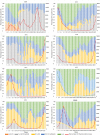Atypical antibody responses to influenza
- PMID: 30116603
- PMCID: PMC6072921
- DOI: 10.21037/jtd.2017.12.122
Atypical antibody responses to influenza
Abstract
Influenza viruses undergo rapid antigenic evolution and reassortment, resulting in annual epidemics and the occasional pandemics. Exposure to influenza virus hemagglutinin (HA) and neuraminidase (NA) antigen, either through vaccination or infection, induces an antibody response able to recognize only the homologous antigenic subtype. However, atypical antibody responses recognizing non-homologous influenza subtypes have been reported during infection and vaccination. Here, we review the incidence of these phenomena in published literature and discuss the potential mechanisms underlying them.
Keywords: Influenza; antibody; heterosubtypic; neutralizing.
Conflict of interest statement
Conflicts of Interest: The authors have no conflicts of interest to declare.
Figures



References
-
- Organization WH. Influenza (Seasonal) Fact Sheet. Available online: http://www.who.int/mediacentre/factsheets/fs211/en/
Publication types
Grants and funding
LinkOut - more resources
Full Text Sources
Other Literature Sources
